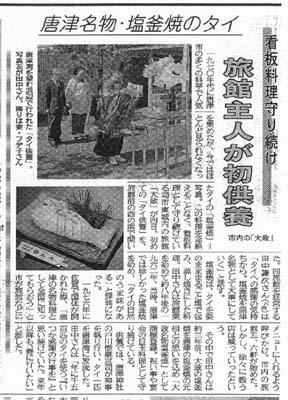Registered Trademark – Oomasa Specialty: Salt-Crusted Sea Bream
Asahi Evening Edition — May 25, 1996 (Heisei 8)
From the “News Lounge” section of Aji-gokoro / Tabi-gokoro

Taikō-yaki – Karatsu, Saga
Saga / Karatsu — Taikō-yaki
It’s called “yaki” (grilled), but it’s not your typical taiyaki (fish-shaped sweet filled with red bean paste).
To put it simply, Taikō-yaki is a dish where an actual sea bream (tai) is wrapped in salt and baked.
The name comes from the fact that once it’s finished cooking, the color and shape resemble the famous taiyaki snack.
This dish is generally known as shiogama-yaki (salt-crusted baking), but in Karatsu City, Saga Prefecture, it’s called “Taikō-yaki.”
Outside the inn Oomasa, located just west of Karatsu Castle, a sign proudly reads “Specialty: Shiogama Cuisine” — and the dish is indeed their signature offering.
Because freshness is key, the preparation begins by scooping a live red sea bream from a tank using a net.
The water is kept at 7°C, and the fish is not fed for 2 to 3 days beforehand to firm up its flesh.
The chef quickly stuns the fish by striking its vital point, removes the scales, and takes out the internal organs.
Next comes the crust preparation.
1.5 kg of coarse salt is mixed with egg whites and kneaded by hand for 2 to 3 minutes until the texture is as soft as an earlobe.
This mixture is then applied to the fish in a layer about 1 cm thick, shaped into a fish-like form, and decorative eyes and scales are drawn on top.
Aside from visual appeal, this also helps release excess steam during baking.
The fish is placed in a gas oven and baked for 30 minutes.
Once the surface turns a golden-brown color, it looks like a giant taiyaki.
“It’s a big hit with the kids,” says Tanaka Fujiko, the inn’s proprietress.
The name Taikō-yaki has historical roots.
Near Karatsu lies Nagoya Castle Ruins in Chinzei Town, where Toyotomi Hideyoshi once set up camp.
According to legend, he was so impressed by the red sea bream of the Genkai Sea that he had it wrapped in salt to preserve its flavor and sent it by express horse to his ailing mother, Lady Ōmandokoro, in Osaka.
Thus, the dish became known as Taikō-yaki (Taikō being another name for Hideyoshi).
The name was coined by the Karatsu Ryokan Association, just before the 1976 Saga National Sports Festival, as part of a campaign to promote local cuisine.
Young chefs from the association came up with the name.
However, there are no definitive historical documents to back up this story.
Although some involved at the time say, “I feel like I saw it in an old text,” local historians and curators at the Saga Prefectural Nagoya Castle Museum say, “We’ve never seen a reliable source.”
Perhaps digging too deeply into it would ruin the charm.
When eating the dish, the hardened salt crust is carefully cracked open with a bamboo spatula so the fish remains intact.
A sweet aroma rises with the steam.
As Tanaka-san explains, the flesh isn’t salty at all:
“Sea bream swim in saltwater, but their flesh isn’t salty. This is the natural flavor of tai.”
The inn recommends eating the dish within 10 minutes of it coming out of the oven — while it’s piping hot.
While Oomasa also offers delivery of Taikō-yaki, they limit it to locations within a 10-minute drive.
Which casts doubt on the part of the legend about the express horse ride to Osaka.
After all, Osaka is much closer to the equally renowned tai-producing areas of Naruto and Akashi than to the Genkai Sea.
Oomasa also tried preparing salt-crusted flounder and prawns, but none matched the richness of sea bream.
This cooking method, which brings out the fish’s inherent flavors, seems to confirm why tai is known as the “king of fish.”
— Written by Yūzō Kuhizume, Saga Bureau, Asahi Shimbun (Evening Edition, May 25, 1996)
Nishinippon Shimbun, Saga Edition — April 7, 2002 (Heisei 14)
Published in the Saga Prefecture section of the Nishinippon Shimbun

Salt-Crusted Sea Bream Lives On at Oomasa Inn — First “Sea Bream Memorial” Held in Karatsu
Once a popular dish served at many traditional restaurants in Karatsu during the 1970s, salt-crusted sea bream (shiogamayaki) has now become a rare sight.
However, Oomasa, a ryokan located in Higashijonai, Karatsu City, continues to preserve this dish as its signature specialty. On April 4, the inn held its first-ever “Tai Memorial Ceremony” on Nishinohama Beach in front of the property.
Kenji Tanaka, the proprietor of the ryokan, said:
“This is an expression of gratitude toward the sea bream. We want to continue cherishing salt-crusted sea bream as a specialty of Karatsu.”
The shiogamayaki dish is made by wrapping a whole sea bream in salt and then steam-baking it.
Tanaka began serving the dish in 1962, about eight years after starting his inn. At the time, salt-crusted sea bream was still rare in Karatsu, and it quickly gained popularity for its natural umami flavor.
When the National Sports Festival (Kokutai) was held in Saga in 1976, the city encouraged local inns and restaurants to promote salt-crusted sea bream as a Karatsu specialty. Around five or six establishments began offering it, but the number has gradually declined over the years.
Amid this trend, about three years ago, Tanaka registered the dish under the trademark “Oomasa Specialty: Salt-Crusted Sea Bream”, asserting its roots at his ryokan.
To this day, he continues to serve it as a highlight for celebrations and banquets.
At the memorial ceremony, Chief Priest Koretsugu Togawa from Karatsu Shrine led a Shinto ritual, and a live sea bream was released into Karatsu Bay.
Tanaka commented,
“We use around 1,500 sea bream per year. I’ve long thought of holding a ceremony to show our appreciation. I hope to continue this event every spring from now on.”
⸻



